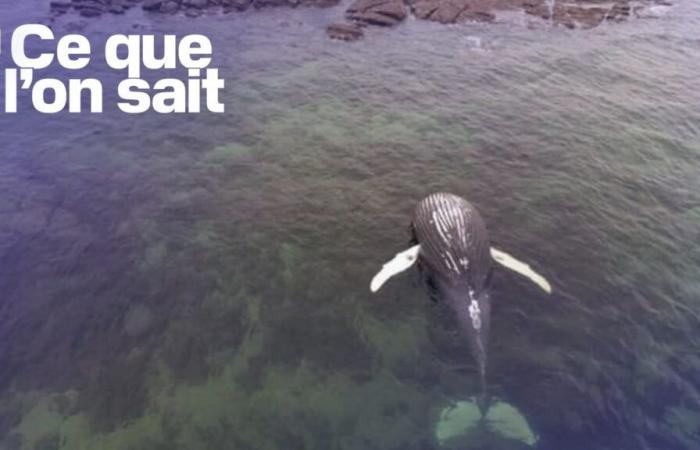A whale weighing 10 to 12 tonnes washed up off the coast of Réville this Sunday, November 10. She was brought ashore and an autopsy was ordered to determine the cause of her death.
A dead whale was discovered stranded off the coast of Réville this Sunday, November 10 in the morning. The cetacean was found on a rocky islet, in the Val de Saire, a place inaccessible on foot near Jonville beach.
• A whale weighing 10 to 12 tonnes
According to the Channel and North Sea maritime prefecture, the whale measures between 7 to 10 meters long, and weighs between 10 and 12 tonnes. The mayor of Réville, Yves Asseline, was warned of the presence of the animal “by the police and firefighters shortly before 10 a.m.”, he told our colleagues from France bleu.
Due to the wind, the rising tide, the currents, but also the decomposition work already underway and the proximity of the body to the coast and economic activities, the authorized services decided “for the rapid removal of the cetacean”.
Indeed, gas emanations had started due to the decomposition of the whale.
• An autopsy and analyzes in progress
The National Navy, as well as the firefighters, the Cross, the gendarmerie and numerous other services were mobilized to repatriate the carcass to dry land. A helicopter marking was first carried out before proceeding to unstrand the cetacean.
After a strict protocol, the whale was able to be brought back to Cotentin soil at the end of the day, at the Jonville hold, the maritime prefecture still details. The carcass must be transported to a specialized site to begin an autopsy.
From this Monday, November 11 and for several days, analyzes will be carried out to determine the reasons for the whale's death, but also to rule out “any health risk linked to the consequences of its stranding near the coast”.
• Multiple hypotheses on the cause of death
Whales are usually difficult and rare to observe in the English Channel. Humpback whales, for example, are more accustomed to the waters of the North Atlantic in summer and those of the tropics. But due in particular to warming sea temperatures, sightings of large cetaceans are becoming more and more frequent in the Channel.
A humpback whale was seen by the Ouistreham gendarmerie near Hermanville on March 11. Yet another animal, probably of the rare species of Sowerby's beaked whales, was for example photographed on Monday October 28 in Calvados, according to the GECC.
So, in addition to sightings, strandings of large whales are also increasing. A phenomenon which is increasing for several reasons, according to Marc Giraud, spokesperson for the association for the protection of wild animals.
“There are collisions with large boats and fast boats. There is noise pollution because cetaceans use sonar. There is chemical pollution, there are also some who are starving,” he already listed. several months ago at BFM Normandie.
The animal may also have been injured by the marine environment or human installations or even been the victim of poisoning. Natural mortality and predation cannot be ruled out.
• Stranded cetaceans are becoming more and more common
Causes that affect whales but also other cetaceans present in the Channel. At the end of July, a harbor porpoise was discovered on a beach in Fécamp. A common dolphin was also found dead stranded on January 4 on the beach of Villerville in Calvados.
In April 2023, a 30-ton whale was stranded on the beach of Saint-Valery-en-Caux in Seine-Maritime. Remains of this same animal were found four months later, in August, on the beach of Veules-les-Roses in Seine-Maritime after a storm.
In two years therefore, two whales have stranded themselves on the Normandy coast, while in 2022 the Pelagis observatory has recorded a total of only six cases of humpback whales stranding on the Channel coast and since the start of the studies. North Sea. The two previously stranded animals were seen in 2022 in Pas-de-Calais, and in 2012.
• A whale already observed in the past?
With the discovery of this whale, many people are wondering if it is the same marine animal observed in mid-October in the Seine, between Rouen and Le Havre. The latter, a humpback whale, disappeared from radar on October 16, although another cetacean of this species was observed on October 19 near Jersey.
On social networks, other Internet users also mention a whale filmed in the bay of Saint-Malo at the end of October.
It is currently impossible to know whether this is the same animal, or several different whales. This type of large cetacean is indeed difficult to observe for specialists. The humpback whale “can move several hundred meters without returning to the surface”, and perform apneas of “more or less 30 minutes”, details the GECC.
Without forgetting the weather conditions, maritime traffic and tides which disrupt cetacean observations in the Channel.






